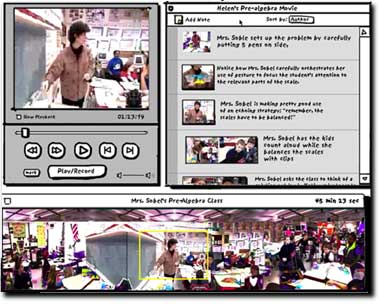Professor
of Education and Learning Sciences
Stanford University
roy.pea@stanford.edu
![]()
DIVER is a Stanford Center for Innovations in Learning project initiated in 2001 but with its roots in earlier work I did with Jeremy Roschelle (Institute for Research and Learning) and Randall Trigg (Xerox PARC) in 1990-91 on VideoNoter. Long-time colleague Michael Mills is key collaborator. DIVER is a project devoted to creating and integrating tools for enhancing the activities of exploring and reflecting on digital videorecords of learning and teaching. Target audiences includes teacher professional development, and learning sciences researchers. Although intended to be useful for archival videorecords, we are building functionality for the novel issues raised when 360-degree panoramic audio-video recordings are made, and one can create "Free-D" virtual pathways through the resulting video arrays.
Roschelle, J.,
Pea, R. D., & Sipusic, M. (1989, April). Design of a tool for video analysis.
Proceedings of ACM/SIGCHI Workshop on Video as a Research and Design Tool,
MIT, Cambridge MA.
Roschelle, J., Pea, R. D., & Trigg, R. (1990). VideoNoter: A
tool for exploratory video analysis. Palo Alto, CA: Institute for Research
on Learning, Technical Report, No. 17.
Publications on the DIVER Project include:
Pea, R., Mills, M., Rosen, J., Dauber, K., Effelsberg, W., & Hoffert. E. (2004, Jan-March). The DIVER™ Project: Interactive Digital Video Repurposing. IEEE Multimedia, 11(1), 54-61.
Pea, R. D. (2006). Video-as-data and digital video manipulation techniques for transforming learning sciences research, education and other cultural practices. In J. Weiss, J. Nolan & P. Trifonas (Eds.), International Handbook of Virtual Learning Environments (pp. 1321-1393). Dordrecht: Kluwer Academic Publishing.
Goldman, R., Pea, R. D., Barron, B. & Derry, S. (2007). (Eds.). Video research in the learning sciences. Mahwah, NJ: Lawrence Erlbaum Associates.
Pea, R., & Hoffert, E. (2007). Video workflow in the learning sciences: Prospects of emerging technologies for augmenting work practices. In Goldman, R., Pea, R. D., Barron, B. & Derry, S. (Eds.) Video research in the learning sciences, pp. 427-460. Mahwah, NJ: Lawrence Erlbaum Associates.
Pea, R., Lindgren, R., & Rosen, J. (2008, September, to appear). Cognitive technologies for establishing, sharing and comparing perspectives on video over computer networks. Social Science Information, 47(3).
